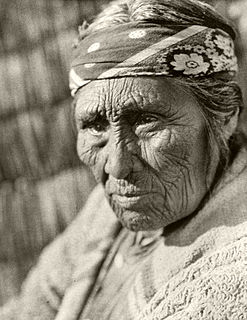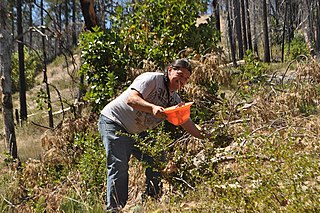Related Research Articles

The Klamath people are a Native American tribe of the Plateau culture area in Southern Oregon and Northern California. Today Klamath people are enrolled in the federally recognized tribes:
Food sovereignty is a food system in which the people who produce, distribute, and consume food also control the mechanisms and policies of food production and distribution. This stands in contrast to the present corporate food regime, in which corporations and market institutions control the global food system. Food sovereignty emphasizes local food economies, sustainable food availability, and center culturally appropriate foods and practices. Changing climates and disrupted foodways disproportionately impact indigenous populations and their access to traditional food sources while contributing to higher rates of certain diseases; for this reason, food sovereignty centers indigenous peoples. These needs have been addressed in recent years by several international organizations, including the United Nations, with several countries adopting food sovereignty policies into law. Critics of food sovereignty activism believe that the system is founded on inaccurate baseline assumptions; disregards the origins of the targeted problems; and is plagued by a lack of consensus for proposed solutions.

The Klamath River flows 257 miles (414 km) through Oregon and northern California in the United States, emptying into the Pacific Ocean. By average discharge, the Klamath is the second largest river in California after the Sacramento River. It drains an extensive watershed of almost 16,000 square miles (41,000 km2) that stretches from the arid country of south-central Oregon to the temperate rainforest of the Pacific coast. Unlike most rivers, the Klamath begins in the high desert and flows toward the mountains – carving its way through the rugged Cascade Range and Klamath Mountains before reaching the sea. The upper basin, today used for farming and ranching, once contained vast freshwater marshes that provided habitat for abundant wildlife, including millions of migratory birds. Most of the lower basin remains wild, with much of it designated wilderness. The watershed is known for this peculiar geography, and the Klamath has been called "a river upside down" by National Geographic magazine.

The Chinook salmon is the largest and most valuable species of Pacific salmon in North America, as well as the largest in the genus Oncorhynchus. Its common name is derived from the Chinookan peoples. Other vernacular names for the species include king salmon, Quinnat salmon, Tsumen, spring salmon, chrome hog, Blackmouth, and Tyee salmon. The scientific species name is based on the Russian common name chavycha (чавыча).

Hupa are a Native American people of the Athabaskan-speaking ethnolinguistic group in northwestern California. Their endonym is Natinixwe, also spelled Natinook-wa, meaning "People of the Place Where the Trails Return". The Karuk name was Kishákeevar / Kishakeevra. The majority of the tribe is enrolled in the Federally recognized Hoopa Valley Tribe.

The Karuk people are an indigenous people of California, and the Karuk Tribe is one of the largest tribes in California. Karuks are also enrolled in two other federally recognized tribes, the Cher-Ae Heights Indian Community of the Trinidad Rancheria and the Quartz Valley Indian Community.

Karuk or Karok is the traditional language of the Karuk people in the region surrounding the Klamath River, in Northwestern California. The name ‘Karuk’ is derived from the Karuk word káruk, meaning “upriver”.

The Pacific lamprey is an anadromous parasitic lamprey from the Pacific Coast of North America and Asia. It is a member of the Petromyzontidae family. The Pacific lamprey is also known as the three-tooth lamprey and tridentate lamprey.

The Yurok are an Indigenous people from along the Klamath River and Pacific coast, whose homelands are located in present-day California stretching from Trinidad in the south to Crescent City in the north.

The California Department of Fish and Wildlife (CDFW), formerly known as the California Department of Fish and Game (CDFG), is a state agency under the California Natural Resources Agency. The Department of Fish and Wildlife manages and protects the state's wildlife, wildflowers, trees, mushrooms, algae (kelp) and native habitats (ecosystems). The department is responsible for regulatory enforcement and management of related recreational, commercial, scientific, and educational uses. The department also prevents illegal poaching.
Traditional ecological knowledge (TEK) describes indigenous and other traditional knowledge of local resources. As a field of study in Northern American anthropology, TEK refers to "a cumulative body of knowledge, belief, and practice, evolving by accumulation of TEK and handed down through generations through traditional songs, stories and beliefs. It is concerned with the relationship of living beings with their traditional groups and with their environment." It is important to note that indigenous knowledge is not a universal concept among various societies, but is referred to a system of knowledge traditions or practices that are heavily dependent on "place". Such knowledge is used in natural resource management as a substitute for baseline environmental data in cases where there is little recorded scientific data, or may complement Western scientific methods of ecological management.
The Klamath River is a river in southern Oregon and northern California in the United States. This article describes its course.

The indigenous peoples of California are the indigenous inhabitants who have lived or currently live in the geographic area within the current boundaries of California before and after the arrival of Europeans. With over forty groups seeking to be federally recognized tribes, California has the second-largest Native American population in the United States. The California cultural area does not conform exactly to the state of California's boundaries. Many tribes on the eastern border with Nevada are classified as Great Basin tribes, and some tribes on the Oregon border are classified as Plateau tribes. Tribes in Baja California who do not cross into California are classified as indigenous peoples of Mexico.

The Klamath Basin Restoration Agreement (KBRA) is an American multi-party legal agreement determining river usage and water rights involving the Klamath River and Klamath Basin in the states of California and Oregon. Discussion of the KBRA began in 2005. Congress failed to pass legislation that would implement the KBRA by the January 1, 2016 deadline.
Blue Creek is a 23-mile (37 km) long stream in the Northern Coast Ranges of California, and is the lowermost major tributary of the Klamath River. The creek begins in Elk Valley, in the Siskiyou Wilderness of the Six Rivers National Forest in Del Norte County. It flows southwest, receiving several major tributaries including the East Fork, Crescent City Fork, Nickowitz Creek, Slide Creek and the West Fork. It flows into the Klamath River in Humboldt County, 16 miles (26 km) upstream from where the Klamath empties into the Pacific Ocean.

The Sioux Chef's Indigenous Kitchen is a recipe book written by Sean Sherman with Beth Dooley, published by the University of Minnesota Press in Minneapolis, Minnesota. Sean Sherman is an Oglala Lakota chef who was born in Pine Ridge, South Dakota, and is currently based in South Minneapolis. Sherman opened an indigenous cuisine restaurant within the Water Works park development project overlooking Saint Anthony Falls and the Stone Arch Bridge in Minneapolis in 2021.

The Klamath river begins below Upper Klamath Lake in Southern Oregon and flows about 300 miles through Northern California until draining into the Pacific ocean. Upper Klamath Lake is the largest freshwater lake in Oregon and was established by the late Pliocene period. The lake fills a graben that is thousands of meters deep. The Klamath Basin lies on the edge of the Basin and Range province and is adjacent to the High Cascades of Southern Oregon.

Susan Masten of Northern California is a leader with the Yurok tribe and the past Yurok Tribal Chairperson. She is a political activist involved with many tribal and women's issues.

Un-Dam the Klamath (#UnDamtheKlamath) is a social movement in the United States to remove the dams on the Klamath River primarily because they obstruct salmon, steelhead, and other species from accessing the upper basin which provides hundreds of miles of spawning habitat. The dams have also significantly harmed Hupa, Karuk, Klamath, and Yurok lifeways and communities. Copco #1, Copco #2, Iron Gate and J.C. Boyle are the four hydroelectric dams on the Klamath River that are being advocated for removal.

Gather is a documentary film about Native American efforts for food sovereignty, directed by Sanjay Rawal and released in 2020. The film follows efforts by various people and groups to reclaim ancestral foodways. It was positively reviewed by critics, and named a Critic's Pick by The New York Times in September 2020.
References
- 1 2 Smith, Heather (2017-08-13). "Two Yurok Brothers, Four Dams, and a Lot of Salmon". Sierra Club . Archived from the original on 2017-08-29. Retrieved 2021-10-09.
- 1 2 3 Wilkes, Mackenzie (2021-08-04). "California's Yurok Tribe grows solutions in soil of crises". Cronkite News . Archived from the original on 2021-08-04. Retrieved 2021-10-08.
- 1 2 Schloredt, Valerie (November 25, 2020). "In 'Gather,' Indigenous Food Sovereignty Is on the Menu". YES! Magazine . Archived from the original on 2020-11-25. Retrieved October 8, 2021.
- 1 2 Begay, Jade (2020-10-14). "'Gather' Centers Efforts to Heal and Rebuild Indigenous Traditions and Foodways". Civil Eats . Archived from the original on 2020-10-27. Retrieved 2021-10-09.